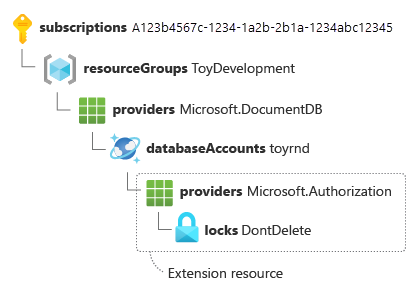Define extension resources
Extension resources are always attached to other Azure resources. They extend the behavior of those resources with extra functionality.
Some examples of common extension resources are:
| Name | Resource type |
|---|---|
| Role assignments | Microsoft.Authorization/roleAssignments |
| Policy assignments | Microsoft.Authorization/policyAssignments |
| Locks | Microsoft.Authorization/locks |
| Diagnostic settings | Microsoft.Insights/diagnosticSettings |
For example, consider a lock, which can be used to prevent the deletion or modification of an Azure resource. It doesn't make sense to deploy a lock by itself. It always has to be deployed onto another resource.
Note
The commands in this unit are shown to illustrate concepts. Don't run the commands yet. You'll practice what you learn here soon.
How are extension resources defined?
In Bicep, you define an extension resource in mostly the same way as a normal resource. However, you add the scope property to tell Bicep that the resource should be attached to another resource defined elsewhere in the Bicep file. You use the resource's symbolic name to refer to it. For example, here's the definition of an Azure Cosmos DB account that we created previously:
resource cosmosDBAccount 'Microsoft.DocumentDB/databaseAccounts@2024-05-15' = {
name: cosmosDBAccountName
location: location
properties: {
// ...
}
}
Let's add a resource lock, which prevents anybody from deleting the Azure Cosmos DB account:
resource lockResource 'Microsoft.Authorization/locks@2020-05-01' = {
scope: cosmosDBAccount
name: 'DontDelete'
properties: {
level: 'CanNotDelete'
notes: 'Prevents deletion of the toy data Cosmos DB account.'
}
}
Notice that the example uses the scope property with the Azure Cosmos DB account's symbolic name. This property setting tells Bicep to deploy the resource lock onto the Azure Cosmos DB account, which means that it can no longer be deleted.
Extension resource IDs
An extension resource has a slightly different ID than other resources. It consists of its parent resource ID, the separator /providers/, and the extension resource ID.
Let's say you deployed the previously mentioned Azure Cosmos DB account, and the account was named toyrnd. Here's what the lock's resource ID would look like:
/subscriptions/A123b4567c-1234-1a2b-2b1a-1234abc12345/resourceGroups/ToyDevelopment/providers/Microsoft.DocumentDB/databaseAccounts/toyrnd/providers/Microsoft.Authorization/locks/DontDelete
Here's a visual representation:

If you see a resource ID that starts with a normal resource ID and then adds /providers/ and another resource type and name, it means that you're looking at an extension resource ID.